
Articulation Therapy: Teaching F and V sound
Articulation Therapy: Teaching F and V sound
The sounds f and v are labiodental fricatives. The name ‘fricatives’ comes from the friction sound that is made when these sounds are produced. When producing fricatives, air flows continuously through articulators (be it the tongue and teeth/lips and teeth) positioned in a specific manner. ‘Labiodental’ is a description of the use of the lips and the teeth to produce the sounds /f/ and /v/.
If these sounds are misarticulated, a speech therapist will assist in bringing an understanding of how the sounds are made and sound, then establishing them, followed by strengthening and generalizing them.
-
How are the sounds produced?
 The sound /f/ is produced by touching the upper teeth to the lower lip and letting out a stream of air/breath. The articulators should not touch too tight, else air will not be let out. A gentle touch should suffice.
The sound /f/ is produced by touching the upper teeth to the lower lip and letting out a stream of air/breath. The articulators should not touch too tight, else air will not be let out. A gentle touch should suffice.
The sound /v/ is produced in the same way (position of tongue and lips) however, voicing (i.e. vibration at the throat level) is the only difference.
-
How is the /f/ sound established?
Work towards establishing the sound if the child is unable to say it correctly. Several children, when younger may substitute the use of the sound /f/ with another for other sounds like /p/. However, by the age of 4, the sound must be used correctly. If not, it needs to be taught.
Establish the sound in the following ways:
-
Can you feel it:
Get the child to ‘feel’ where s/he should place the lips and tongue while saying the sound. This can be achieved with a little food. Place a small amount of a sticky food item (chocolate, peanut butter etc.) on the lower lip. Allow the child to sweep it with the upper two teeth. This provides wonderful tactile feedback to the child. Once the child understands this aspect, moving to the use of mirrors and more drilling is needed.
-
Use a mirror:
The /f/ sound is easy to see and therefore can be easy to learn. A mirror is a great tool to give the visual feedback to the learner. Let the child ‘see’ how his teeth and lips should be placed. Imitating placement of the therapist is great. Keep a mirror big enough to be able to see both faces together.
-
Fog it:
Once the child is aware of the placement, this can be taken up. Use a smaller mirror held closer to the mouth when the child is saying the /f/ sound. Since there would be a long breath out when saying the sound, the mirror will fog up. This will help the child learn to use the sound with a stream of air.
* Note: Before working on producing the sound, listening and identification of the /f/ and /v/ sound may need to be taken up. Let a speech therapist guide about the need for this.
-
How to work on the sound /v/?
Voicing differentiates the sound /f/ and /v/ (as was the case for /p/ and /b/ sounds). Let the child learn the /f/ sound first and then add the aspect of voicing. Take tips from the previous article/s in this series.
When the child learns voicing, get him/her to understand to ‘turn on’ voicing for the /v/ sound.
-
How to build the sound(s) at syllable, word, sentence and conversational level.
Achieving the sounds /f/ and /v/ in isolation is the beginning. Hereafter, there is a need to engage the sound at syllable level (i.e. the sound along with other a vowel) and thereafter longer utterances.
In Syllables.
Allow the child to practice the sound with different vowels (placed before and/or after). Use a visual (like that of the syllable wheel) to get the child to use the sound and practice them with vowels.
Alternately, you can make your own game like one of ‘What does the Giant say?’ (inspired by the story -Jack and the Bean stalk). Here the therapist can be ‘Jack’ and hide from the Giant (the child). The child needs to say ‘Fee Fi Fo Fum, I can smell ___therapist’s name___’.
(Read previous articles *here* in the articulation series to know about the syllable wheel and other games to build a sound at syllable level).
In Words.
Read about how to build a work list in a previous article here. Practice a word list through fun games such as:
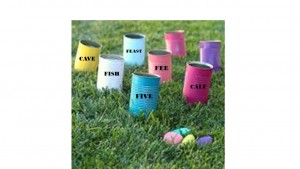 Bean Bag Throw. Prepare cans that have words written on them (choose the words from the word list). Take turns with the child to throw bean bags into the cans. The player throwing must say the words in which the bean bags falls.
Bean Bag Throw. Prepare cans that have words written on them (choose the words from the word list). Take turns with the child to throw bean bags into the cans. The player throwing must say the words in which the bean bags falls.- Say it from a bag. In an opaque bag, have words written on paper. Once again choose from the word list. Each player picks one paper at a time. The name on the paper must be said out loud by the player who picked it. Each player gets a point for saying the word correctly. The player with most points wins.
In Sentences.
If the child can use the sounds well within words, then move on to practicing the sounds in sentences. At first, short sentences should be used – two to three-word sentences. Follow this with longer sentences and paragraphs/stories.
Create a list of sentences with the sounds for the child to practice. For example – (1) Five fish. (2) The frog laughed often. (3) The elephant and calf forgot their headphones in the safe.
Make practice fun. Use the sentences to make and play fun games. For instance,
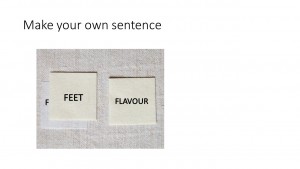 A game of ‘make your own sentence’. Place words (with target sounds) written on a paper upside down in front of the player. Each player will pick up two words at a time. They will frame sentences from the word. The sentences can be funny or absurd. That makes the game more fun! For children who do not read, use pictures. To make the game slightly more challenging, make each player pick up 3 or 4 different words.
A game of ‘make your own sentence’. Place words (with target sounds) written on a paper upside down in front of the player. Each player will pick up two words at a time. They will frame sentences from the word. The sentences can be funny or absurd. That makes the game more fun! For children who do not read, use pictures. To make the game slightly more challenging, make each player pick up 3 or 4 different words.
Books are a great way to practice words and sentences. If a child can not read, they can repeat what the parent or therapist read out. The pictures can be encouraging for the child. 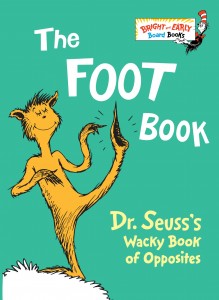
A few books available in bookstores that can encourage the /F/ and /V/ sounds are – One fish, two fish, red fish blue fish (Dr Suess), The foot book (Dr Suess), The Viper (Lisa Thiesing), 1 vote 2 votes, I vote you vote (Dr Suess), The Animals’ Vacation (Shel Haber and Jan Haber), The Bears’ Vacation (Stan and Jan Berenstain). The books encouraging the practice of the sound /v/, have limited words in it. Whenever a word with /v/ is presented in the book, it can be emphasized by the adult.
In Conversation.
Using the sounds correctly within a conversation is quite important. This can be worked upon once the child does well in practicing the sounds in sentences and paragraphs. Within a conversation, you would want the child to use the sounds correctly without having a prepared script.
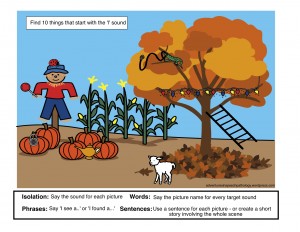 Daily life conversations
Daily life conversations
It should be the main time the sounds are practiced within a conversation. Apart from this, it can be fun to play games, wherein the child may have to create and use conversations. An interactive and creative manner to do this is to play a game ‘Describing a situation’. A prepared picture of a situation can be presented to the child. In simple conversations, the child is to describe the different aspects of the picture to the adult. It must be remembered that the picture/ situation must target the sounds that are to be practiced.
The sounds must be practiced often, to help the child produce them more clearly. If s/he is making several errors and mistakes while using the sound(s) in a conversation, then remember to move a step back and once again practice the sounds within sentences.
Hope this article provides guidance to producing the sounds /f/ and /v/. There are several other ways to work on the sounds. Do share your ideas. We would love to receive comments from you about them.
Subscribe to us to receive more articles about Articulation therapy.
- What is speech therapy and what Speech Therapist Do? - December 22, 2022
- 5 Simple Ideas to Make Flashcards Fun - June 28, 2018
- Should I use ‘NO’ with my child? - June 24, 2018

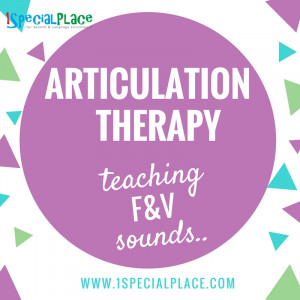
Leave a Comment
(0 Comments)